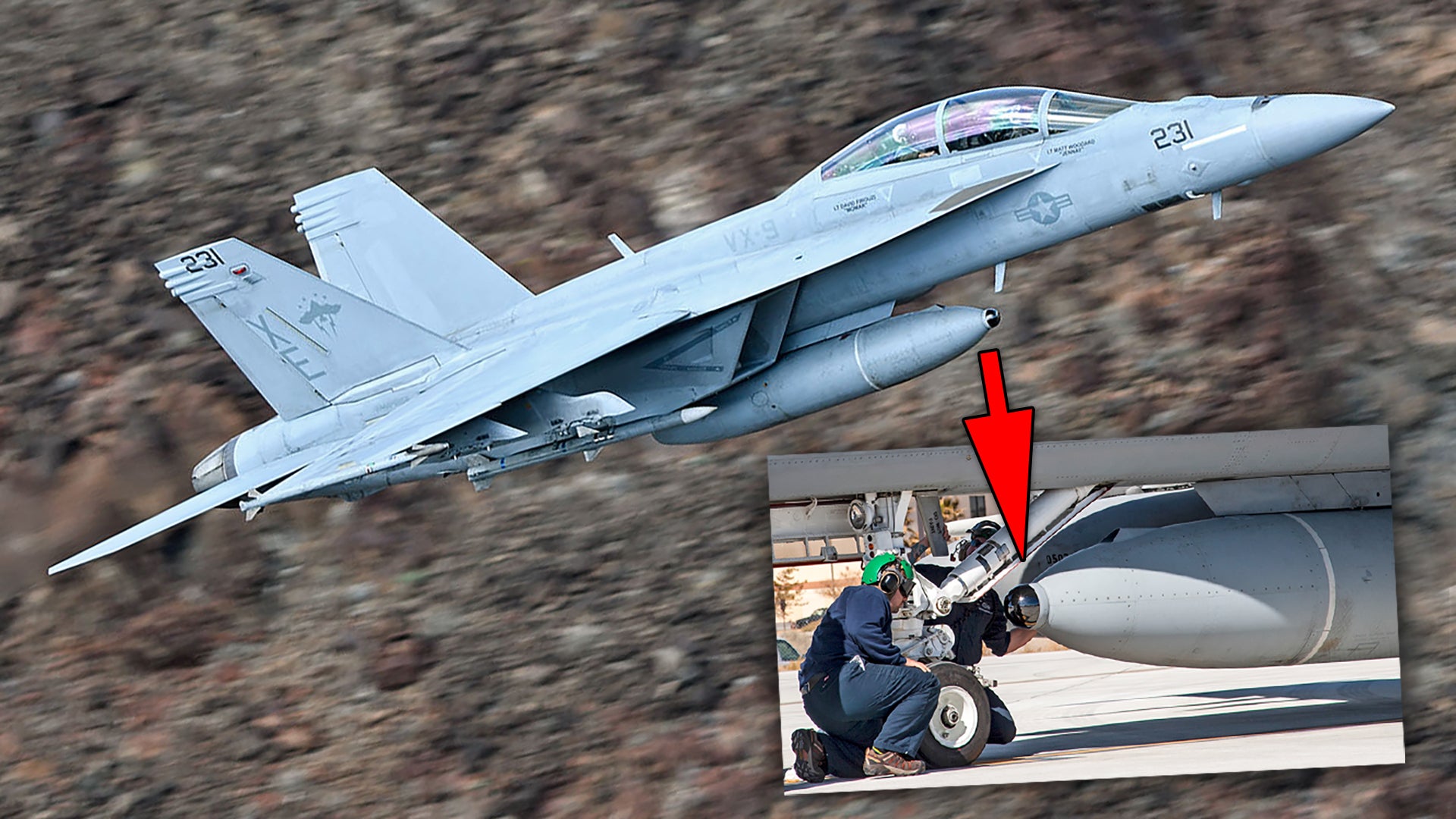The Navy’s fleet of F/A-18E/F Super Hornets keeps getting better with age as it soars into the middle of its service life. The latest Block III upgrade package, which will be applied to many earlier Super Hornets and new build models going forward, will offer a big suite of improvements that you can read all about in detail here. These Super Hornets and earlier Block II ones will soon be able to take advantage of an old concept that has become incredibly relevant once again, not to mention far more potent with an injection of new technologies—the Infrared Search and Track system, commonly referred to as IRST.
The Navy has gone without any form of an IRST for nearly a decade and a half, but that is about to change as the Super Hornet’s IRST is slated to enter operations with the fleet in September of 2021, and it really couldn’t come sooner. With the proliferation of stealth technology and advanced electronic warfare capabilities, being able to leverage a passive sensor, one that uses the infrared spectrum alone, to detect and track airborne targets far beyond-visual-range is becoming essential. Not only can the IRST do this independently, but now, leveraging the latest in sensor-fusion capabilities, it can provide another critical sensor data stream that can corroborate a flight crew’s situational air-to-air ‘picture’ at any given time. It can do this while being totally immune to electromagnetic jamming and other electronic attacks, and it can see right through radar-evading stealth technology.

Captain Jason Denney, head of the Super Hornet and Growler program for the U.S. Navy, was kind enough to field an in-depth interview and share his enthusiasm for this critical new capability with The War Zone. The discussion below answers a lot of questions many may have about the Navy’s IRST ‘renaissance’ of sorts, such as how the Super Hornet’s IRST ended up in the nose of an external fuel tank and how the sensor differs from its evolutionary predecessor found on the F-14D Super Tomcat before its retirement.
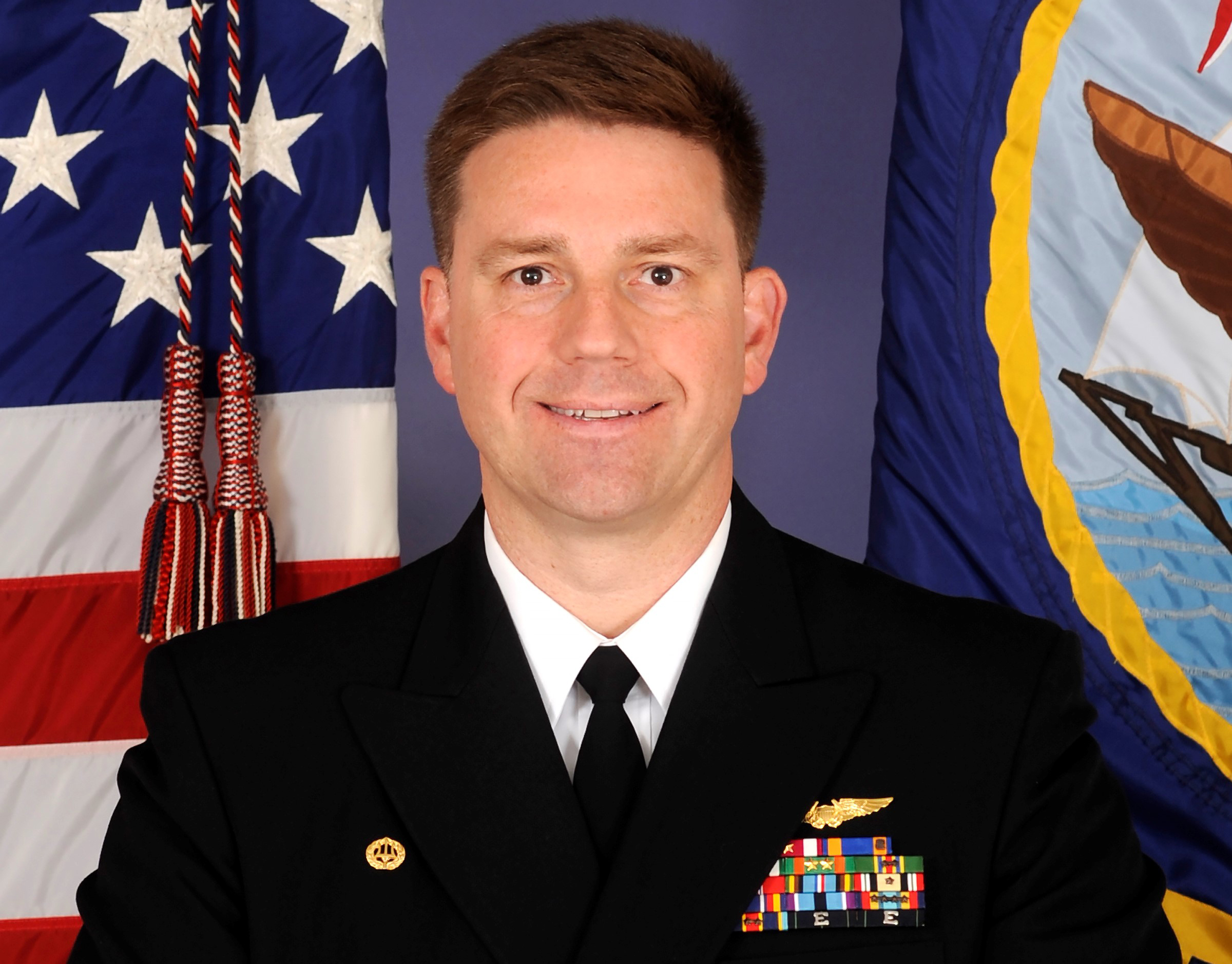
For complete context and background, you can read an in-depth primer I wrote on IRSTs some time ago by clicking here.
Now, without further ado, lets launch into the fascinating and potentially game-changing world of cutting-edge Infrared Search and Track systems with Navy’s officer tasked with leading the Super Hornet into the future:
TR: The last time the Navy fielded an IRST was on the F-14D Super Tomcat. That aircraft was pulled from service 14 years ago. What capability was lost with its retirement?
CD: So, an IRST is just another part of the spectrum. So, yes, when we retired the F-14 and we didn’t have the follow-on IRST readily available, we lost access to that part of the spectrum. So, if you think about the spectrum, I like to use analogy because I can get the concepts that I want across without broaching anything that is sensitive or classified. So, if you think about the electromagnetic spectrum, you’ve got parts of it that are widely used and have a lot of traffic like I-5 [the Interstate 5 highway], right? And then, you’ve got other parts of it that not a whole lot of traffic, they’re kind of like that side road, that country road that’s got a lot of stoplights and things.
If you’re trying to get to grandma’s house, I-5 is probably the quickest, most direct way to go. You can get there via the side road, but they may not have been cleared from the latest snow, or you’re going to run into some traffic in small towns, but it’s a viable way to get there. So, when we didn’t have the IRST ready to go when we retired the last F-14 squads [squadrons], we kind of lost that off-ramp into that side road and we’re kind of limited to I-5. So, you can see that when you get a traffic jam on I-5, you’re either stuck or if you have the ability to get off and take that road, you have another viable way to get there.
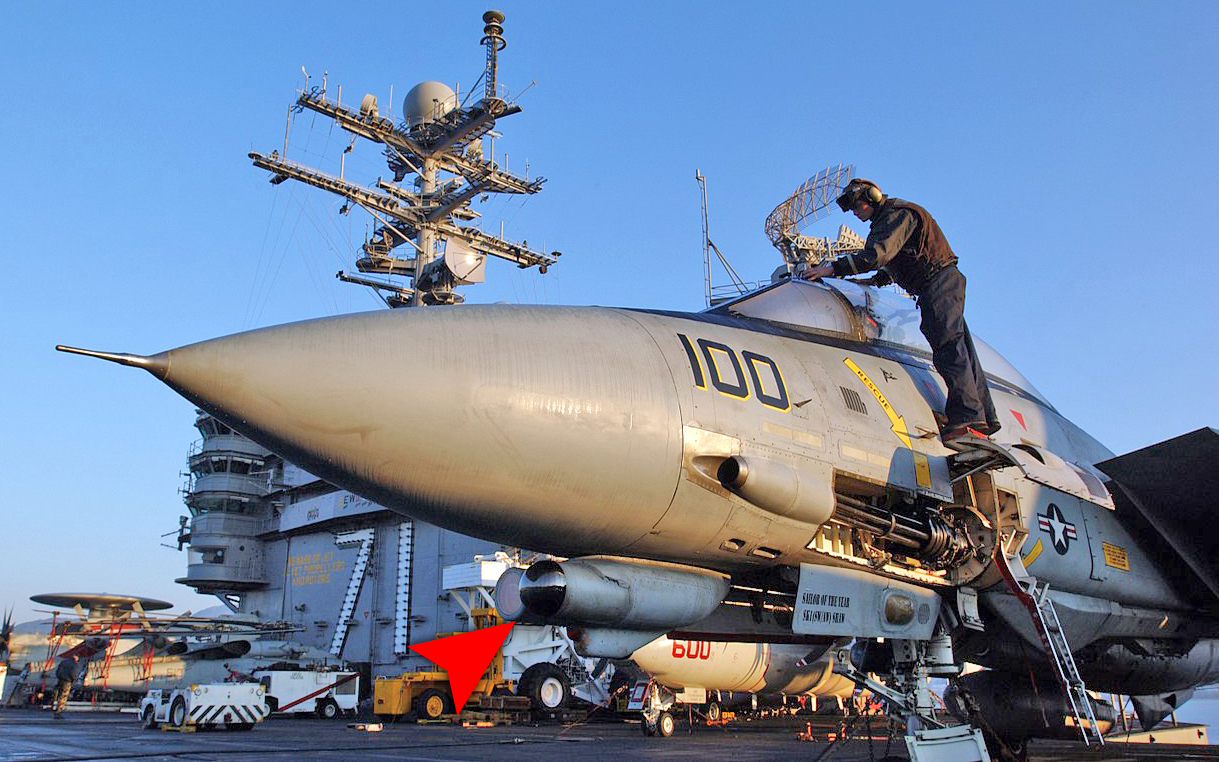
TR: Why does the service want the capability back now?
CD: It wasn’t wanting it back now… You got to look at what aircraft were out there at the time, and then, what were we doing at the time with those aircraft. So, throughout the ’80s and ’90s, you have the Tomcat and that was our air-to-air interceptor. We could do some air-to-ground stuff, but it was an air-to-air machine. And I’m a former Tomcat guy, I was a B guy, I never flew the D, but that thing was an air-to-air machine. Then you had the F-18 [Hornet] that was designed as a replacement for the A-4 and the A-7 with a limited amount of air-to-air capability, right? And then, going throughout Navy fighter history, the dark times of the ’90s where Tomcat 21 got shut down, Navy Advanced Tactical Fighter didn’t go anywhere, A-12 got shut down, and the Navy is staring at a blank slate going “What’s our plan?” And so, that’s when they came up with the Super Hornet. “Hey, let’s build a bigger, better Hornet,” if you will.
So, it wasn’t a “We got out of the IRST business.” It was just kind of where the aircraft were going at the time and what they were designed to do. If you look at the F-18, one of the aspects that it has that none of the other aircraft that carry an IRST in the nose have, is the location of the gun. Our gun is squarely right in the nose of the aircraft. The other closest one is the F-14, where it’s kinda underneath the aircrew. So, there’s really no good place to put it in the nose without completely redesigning the whole nose of the aircraft. That was not what they had planned to do with the E/F [Super Hornet]. They needed it, they needed it online now, the cost and the schedule were paramount. So, they said, “Hey, let’s get the airframe out there and then we will catch up with the sensors when we need to.” Then, fast forward… So, that’s the Block I Super Hornet.
In the Block II Super Hornet, they were focused on redesigning the forward fuselage and to integrate the APG-79 AESA [active electronically-scanned array radar], because we wanted that monster radar in there. About the time that this was going on was the early 2000s and we accelerated getting out of the Tomcat business a couple of years early.

So now, about the time that we got Block II [Super Hornet] out the door, with AESAs at a point where we could field that, now we’re looking saying, “Okay, what capability do we need to bring back, now that we’ve retired the Tomcat?” IRST, first on the list. So, that’s when they came in, and our first CDD for that, our Capability Design Document, was in 2007.
That kind of matches right about when we had got that first tranche of Block II capability, which had new mission computers, a new software language, the APG-79, all that stuff in there that we were able to actually now start integrating.
TR: The IRST21 that is being fielded on the Super Hornet is based on the F-14D’s AAS-42. What improvements have been made to the sensor in 30 years since it was first fielded?
CD: Yeah, great question. So, for the sensor itself, we’ve improved the optical design and the detector technology to get up with the 30 years of advancements, and then to provide some improved sensitivity and performance. That’s pretty much all I’ll say about that. The rest of it really has been a lot of reliability and maintainability stuff. We put a new IMU [Inertial Measurement Unit] in there and upgraded the gyro electronics, so that it could maintain a track more accurately, in line with where we are with technology today. Then a lot of the R&M [Reliability and Maintainability] stuff… We couldn’t get the circuit cards anymore, so they were completely obsolete. So, we had to go redesign those and use more modern chipsets and things like that.
Then, things, even just for keeping it on the wing longer, if you will, there’s a gear drive that they use to control the elevation, and we found that it was susceptible to getting dust in it and the gears not working properly, so we replaced that with a band drive. Then things like brushless motors, those types of things, just so that when we finally field it again, it has more time on the aircraft and less time being down for maintenance, which was one of the things that really hurt the Tomcat IRST.
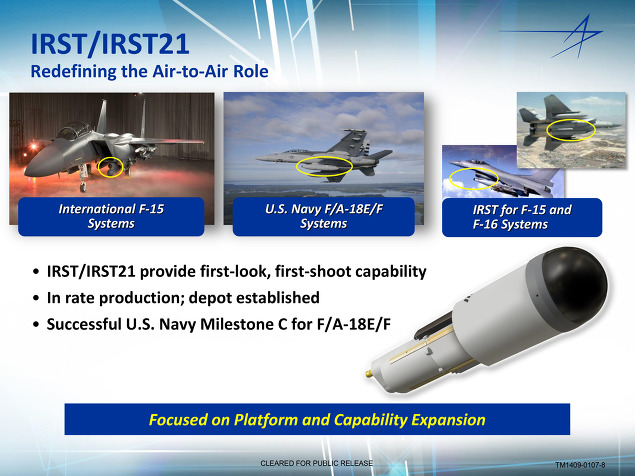
TR: What’s the current state of the program? Have operational units received any early production models? What is the current fielding schedule and how many are each squadron slated to get when it does hit the fleet?
CD: Alright. So, some of that belongs in CNAF’s [Commander, Naval Air Forces] wheelhouse and we can talk about that later, but let me talk at the end of your question… I’m gonna jump around a little bit, because right now, we are in developmental tests of Block II. That’s going through developmental tests this year and we’re gonna transition to operational tests sometime next year, for the Block II IRST. Now, originally, the Block II IRST was the original IRST that we wanted on the airplane. Due to sequestration, budget cuts, and things going on in the earlier part of this decade, they split it apart, so you have the Block I and the Block II [IRST]. For various reasons, we did not put the Block I out into the fleet as per the plan and a lot of that had to do with folks not really understanding how to use the IRST. We can talk a little bit about that later. So right now, that’s where we are, in developmental tests on Block II.

For acquisition planning purposes, we have an idea of how many will go to each squadron, but that’s just so that we can budget out how many we need to buy a year, how much that’s gonna cost, so Congress can hold us accountable and things like that. We have a number in mind for what each squadron would have, but once it’s fielded, that’s all up to CNAF. They’re gonna learn how reliable and maintainable it is, or maybe the tactics, techniques, and procedures. There was an assumption made when we said, “Hey, we’re only to give half a dozen to each squadron at fielding.” They say, “No, we’re gonna use it in a different way now. And now we need 10 or 12 in each squadron.” So, they’ll move those assets around, and we’ve done that with everything from ATFLIR [Advanced Targeting Forward Looking Infrared], to ALR-67 [radar warning recievers], to the ALQ-214 jammer. So, that’s all just depending on the fleet use…
TR: What type of testing has been done to validate the system? Is there any work being done with the Air Force, which is running a very similar program for the F-15 and potentially the F-16?
CD: Yeah, we did full DT [developmental testing] on the Block I, and like I said, we’re in DT for the Block II now. We’ve done carrier suitability and various things like that, just to make sure that the system noise and vibration, all those types of things, and on performance, like going, “Hey, run it against the sensor, against different scenarios,” and things like that. So, that’s really how we do developmental test. Operational test, as you know, is where we give it to the operational testers and they try and use it, kind of how they would think that they would use it in the fleet and say, “Hey, is this operationally suitable or effective?”
TR: Right. And that’s upcoming still at this point?
CD: Correct.
So, you’d asked a question about the Air Force. We haven’t done anything specifically, co-development-wise with the Air Force. There are certain [common] aspects of the IRST, what they’re developing and ours. So, with the hardware modifications, things like that, we’ve kept a lot of those common, and commonality helps us when it comes down to configuration management or being able to buy huge blocks of them. If we all had, say, the same circuit card, for example, then, hey, we combine the Air Force and the Navy buys and then we all get a better price for it. But other than that, we really haven’t done a whole lot of close coordination because their requirements and their implementation are very different than ours.
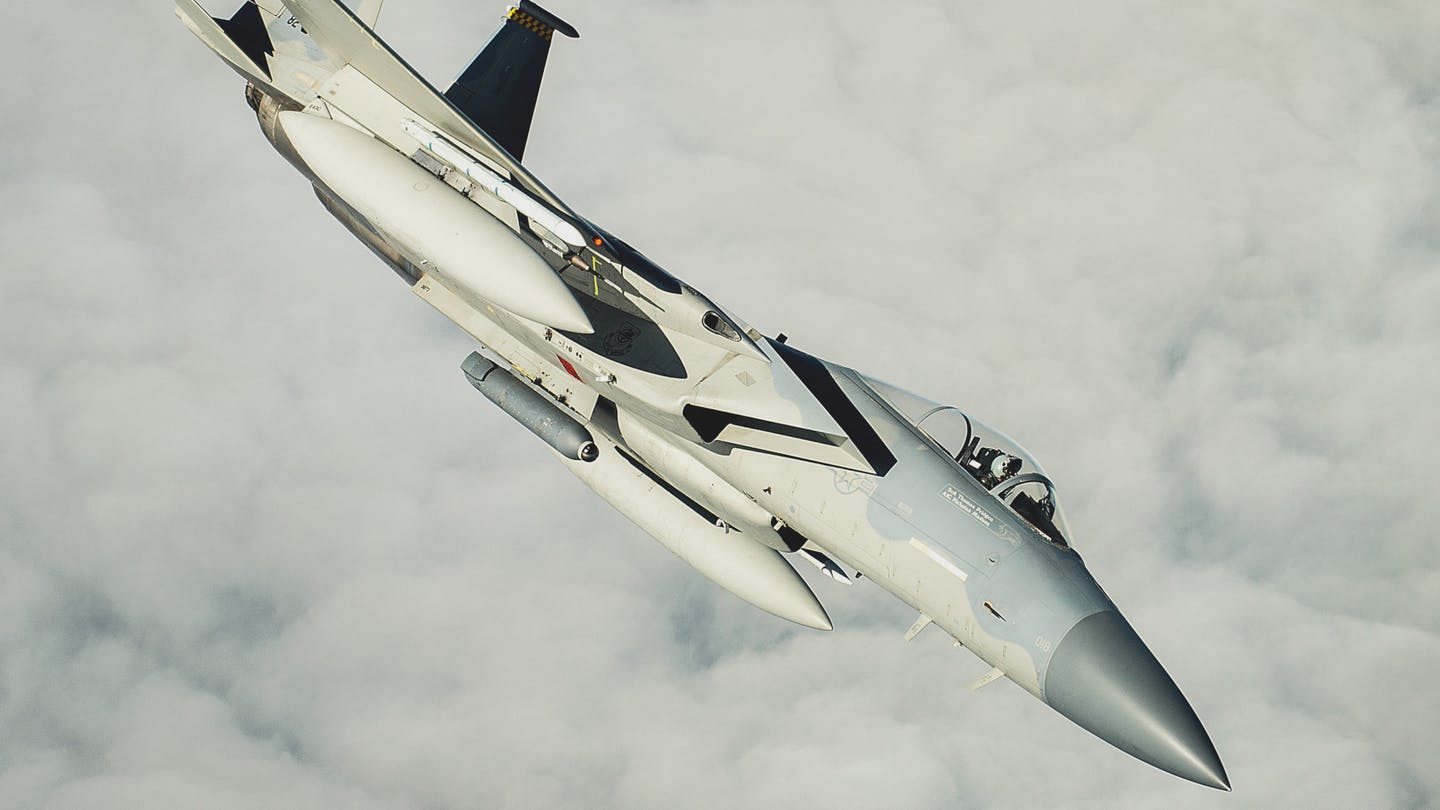
TR: The IRST for the Super Hornet is being fitted on a centerline external fuel tank in a package form where it’s all together in one. Why was this chosen over mounting it somewhere internally? I know we talked a little bit about the gun being an issue, but what about another podded form, like, say, on the intake station, or on a wing station?
CD: Yeah, so that’s a great question. I was actually a lieutenant in my first tour of the VX-31 [Air Test and Evaluation Squadron 31] when this debate began, and I will tell you, there were a lot of opinions and a lot of heated discussions about it. But ultimately, it came down to, you got a balance of the size/weight/power/cooling requirements of what the IRST would be, what’s available on the aircraft versus how much money it costs to develop and integrate that form factor. Then you balance that against the field of regard versus giving up a weapon station versus giving up fuel. So, there were all kinds of discussions on, “Hey, if we put it in a dedicated pod kinda like the Air Force has done, on the centerline, okay, that mitigates the fact that we don’t have room in the nose. And that gives you a pretty good field of regard left and right, but now I’ve given up 3,300 pounds of gas.”
Okay, well, that’s no good, especially on the Super Hornet. Now, you’re limited to having to carry double-bubble fuel tanks. “Well, okay, now I’ve given up two weapon stations instead of one.” So, there are all these iterations of, “Hey, where can we put this thing?”
Then, again, back in 2006-2007, when we were having these discussions, we were right in [the] middle of OEF [Operation Enduring Freedom in Afghanistan] and OIF [Operation Iraqi Freedom]. So, having the ability to carry varied loadouts and maximum flexibility on what you could carry meant that nobody was really willing to give up a weapon station. So, they weighed all of those options and it came down to, “Hey, if we put it in a fuel tank on the centerline, we get the best field of regard that we can, because if you put it on the left or the right wing, you’re blanking one side of the aircraft or the other.” It’s kind of odd to put a sensor in a fuel tank, but now I’m only giving up 900 pounds of fuel instead of 3,300 pounds of fuel.

That was kind of the trade-offs that went into, “Okay, why are we doing it this way?” And those are the big things, plus, like we said, trying to find room for it in the nose, you’d have to remotely mount the electronics for the optics and they didn’t really know how to do that at the time, to work around the gun. So, cost and integration-wise, it was supposed to be simpler and easier to put it where it is.
TR: There have been some questions regarding that location where it’s on the centerline, that it would block a lot of the sensor’s upward field of view, but it’s good left, right, and down. How does this actually work in practice? Is it a major limitation?
CD: I can’t get into details of what the field of regard is, but I will say that, in general, unless you are lined up pretty much exactly on centerline, really close and really high, the IRST is gonna see you. Its field of regard is actually surprisingly good, because remember, you’re down and aft. So, like in the Tomcat, if I was up close to the chin and underneath the nose, that nose is blocking more angles than maybe if I’m further down and away from the nose. And then, we never fight by ourselves, so I’m going to have a wingman out there, hopefully he’s offset enough and has enough range that his IRST is gonna be able to pick up what mine doesn’t and vice-versa.
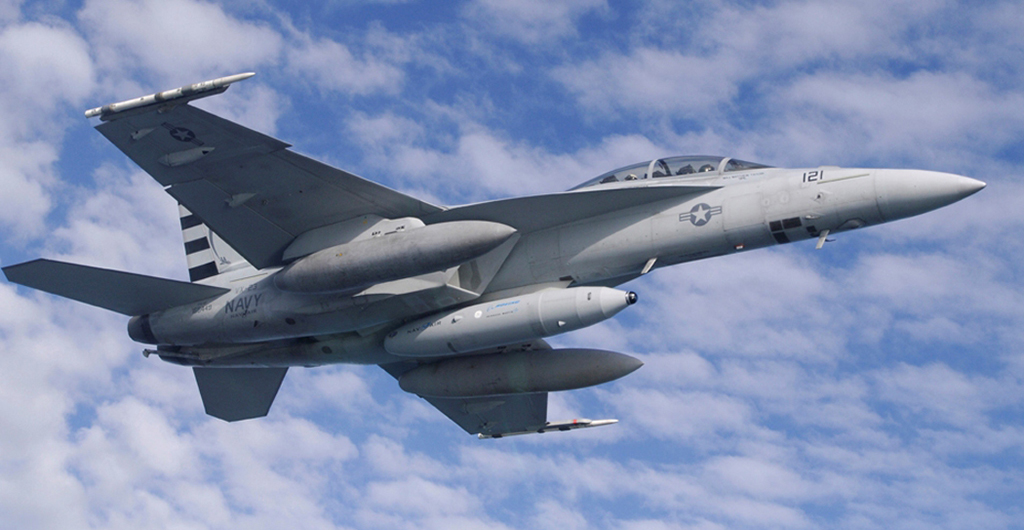
TR: Right. How will the Super Hornet pilot use an IRST? Is it integrated and fused into the mission systems on the aircraft? What do they see in a cockpit, information-wise, when they employ it?
CD: Interestingly enough, in the Tomcat, it was completely separated. And I, as a RIO [Radar Intercept Officer], my job was managing all the sensors. So, when I talk to some of my F-14D RIO buddies, that was one of the things that the pilot used, the IRST, and the RIO managed the radar, and then they kinda correlated together as they got closer to try and figure out what the information was telling them. Obviously, that doesn’t work very well in a single-seat cockpit like the F-18E. So, there will be much tighter integration with the systems.
We do have our version of fusion, it’s called MSI. It was originally Multi-Sensor Integration, but it’s kinda changed to Multi-Source Integration since we added Link 16 into the mix. What that does is, it was originally designed for the legacy Hornet, was to be able to correlate an IFF [Identification Friend or Foe] hit with the radar track. If the computer says, “Hey, okay, I’ve got an IFF hit here and I got a radar track here, yes, those are the same track.” So, we’ve added Link 16 over the years, and now IRST is going to be a contributor to that as well. So hopefully, what the pilot will see is a fused track on his display that says, “I’ve got a contribution from the radar, IFF, Link 16, and an IRST.”
TR: And for stealthy targets, that means if it doesn’t show up on radar, you’re still going be able to get some sort of sensor location off of it, hopefully. That’d be the goal, correct?
CD: Yes. So, depending on what’s out there, maybe there’s a Link 16 track that’s somehow able to either not get jammed, or they’re in a different band of radar, that says, “Hey, we’ve got somebody here and the IRST can correlate with that,” sure, absolutely. But they’re supposed to, hopefully, see some sort of information out there correlated with the other information that’s in the jet.
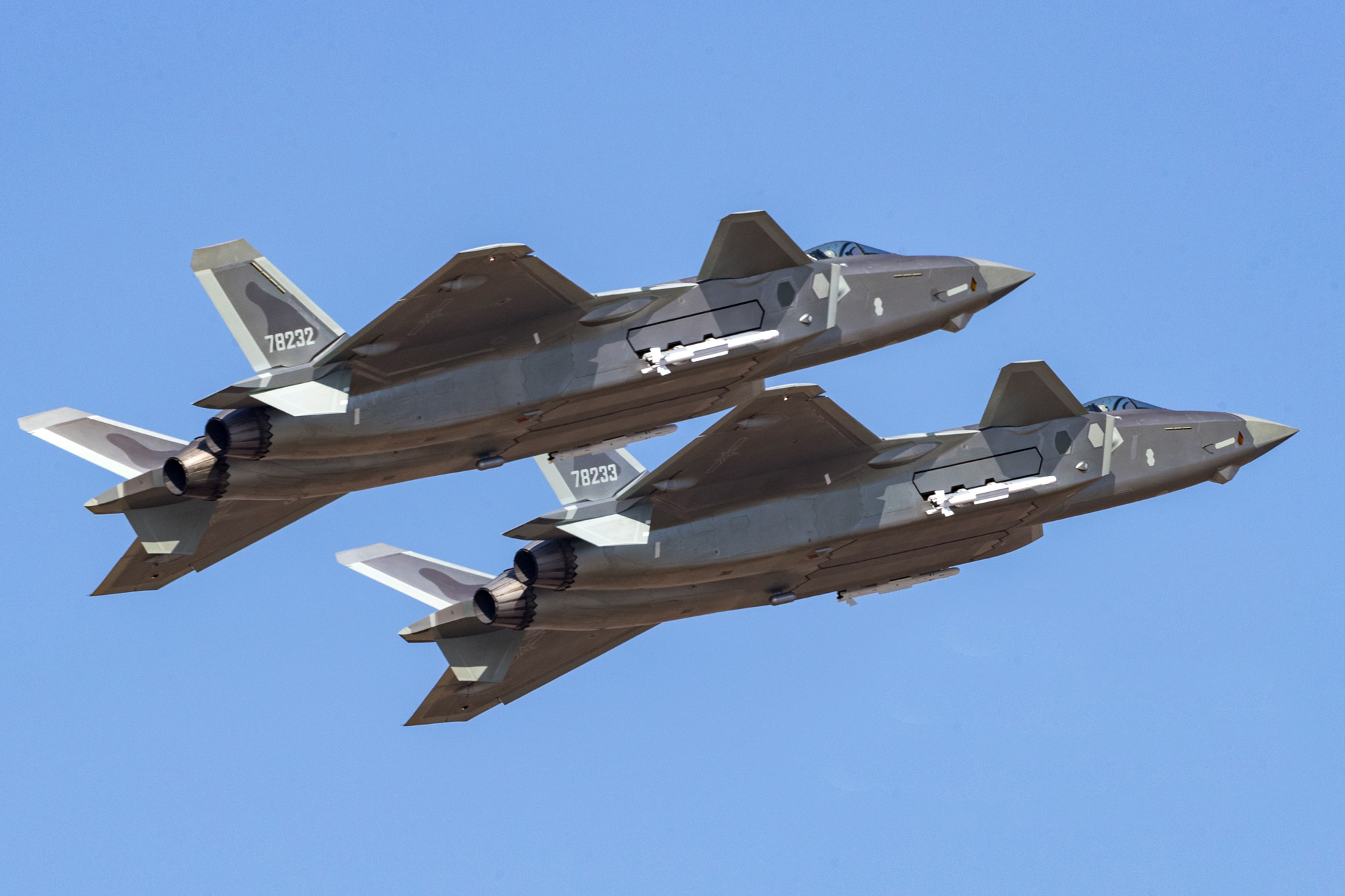
TR: Are there different modes that the sensor can operate in, kind of like a radar? Does it provide an actual image to the pilot of the target for them to even get an idea of what it is, if it’s a fighter or what type even?
CD: So, that would be specific capabilities and we’re not gonna talk about the image piece of it. But as far as the different modes, yeah, actually it’s much more akin to a mechanically-scanned radar than it is anything else. Which is interestingly enough, with this generation of JOs [Junior Officers] that have grown up with AESA, to go back and teach them, “Hey, you’ve gotta actually have dedicated mechanics to make sure the thing’s pointed where you want it to,” has been interesting to see, because I grew up with mechanically-scanned radar and it was almost a joke to go to AESA.
So, yeah, it has a couple of modes, more like the Track While Scan [TWS], if you’re familiar with TWS on mechanically-scanned radars. So, it’s TWS-Manual, TWS-Auto, where either you pick where the sensor’s looking or it picks where the sensor’s looking based on what track it sees. So, it’s very much in line with a mech-scan radar construct.
TR: It can track multiple targets at one time?
CD: Yes, it can track more than one target at a time.
TR: I know range figures are confidential, but is there any way you can just speak to sort of what it’s supposed to be able to see, just generally, and how weather and whatnot would impact a sensor like this?
CD: We won’t get into specifics, that’s capabilities, but you’re really talking about physics now at this point. So range, if you think about the submarine using its sonar, it’s the same kind of thing, it’s a passive sensor. I can get a line of bearing from it, but other information? Now I’ve gotta do something. So, if I take a line of bearing on anything, and then I move, and I take another line of bearing, and I take another line of bearing. Eventually, I can get kind of a sense of where that thing might be. And if that’s a stationary target, that’s easier. If it’s a moving target, or if I’m stationary and the target’s moving, okay, I take a cut, take a cut, take a cut, I can then tell generally which direction he’s going, but without knowing something about the range or something about the velocity, I gotta make some assumptions… If it’s really close to me, then it may be going really slow to have that same angular displacement in the same amount of time as if it’s really far away from me, then it’s gotta be going ungodly fast in order to have the same angular displacement, right? So, in order to determine range and things like that, there’s a whole lot of crazy math that has to go on, and in the end, your radar is a much better range sensor than an IRST is. Does that make sense?
TR: Yeah. And I’d imagine since you’re all data linked together, you could have a couple of Hornets working together with their IRSTs to figure out triangulation and that sort of thing using that same math, correct?
CD: Well, so that would go into specific capability, but like I said before, I have Link 16 tracks coming across, so if somebody else has a range on a track and now my IRST can correlate to it, then I can start correlating my sensors.

It’s an extra tool in the toolbox that gives me options that I wouldn’t have otherwise if I didn’t have it. Then to your question on weather and things like that. Yeah, just like every other IR sensor out there it is also a slave to physics, which is beautiful because physics doesn’t care what side of the conflict you’re on, it plays fairly both ways. There are parts of the spectrum where either oxygen or water vapor really crush your transmissivity, or if I’ve got a lot of water droplets or things in the air, it’s gonna decrease the amount of infrared radiation that’s able to make it to my sensor, and it’s going to degrade performance. Believe it or not, that happens to our radar as well. If I see enough water vapor or… Well, not water vapor, but water droplets in the air, my radar can pick that up, and it’s actually a useful thing because now I have basically a poor man’s weather radar. I can steer myself around thunderstorms and such.
So, there are gonna be limitations to it, and we just have to work through those, and sometimes you can turn them into an advantage. If you think about a submarine that’s got the different thermal layers it has to deal with, it actually uses those to hide rather than complain about, “Well, my sonar doesn’t work going through a thermal layer.” So, these are all kinds of things that, going forward, what kind of mindset do you have? Is it, the degraded performance, is that really always a bad thing or maybe it’s helping hide me from them as well?
TR: Right. Will it be able to work in a missile defense role? Or checking out surface targets? Detecting stealthy surface targets, that sort of thing in the future? And is this something that would be tied into CEC?
CD: Yeah, that’s all capabilities and TTP. Sorry, Ty.
TR: No worries. Obviously, you’ve gotten a lot of pilot feedback because this thing has been in the air in some form for years now. What are they telling you? What’s their perspective on the new sensor and how do they see it fitting into their potential gameplans during their training and operations?
CD:
Topgun is giving us a lot of good feedback right now, believe it or not, because they’re working through trying to figure out what the TTPs are going to be so when we fleet release, the fleet has them ready to go. So, a lot of the feedback we’ve gotten is, like I said, the, “Hey, once you have to manage another sensor and get used to using a mechanically-scanned sensor again,” and they’ve wrapped their heads around that, the feedback’s generally been very positive. A lot of the other feedback we’ve got is more crew-vehicle interface and the ability to… Maybe I can slave it to the radar or I can slave the radar to the IRST, things that we used to do in the Tomcat. But just how that plays out, so that either in an E-cockpit or an F-cockpit, the aircrew can maximize the potential benefits of the sensor. But generally, the feedback has been very positive.

TR: Has the Marine Corps shown any interest in maybe adding something like this to their legacy Hornets that are getting the upgraded with the AESA radar and everything else?
CD: Yeah. So, that’s not a priority for them right now, at least IRST, the legacy radar upgrade is. And it’s just management of resources and the amount of time they have left on that platform. It takes time to integrate these things, and are they going to get a return on investment by the time they get it on to, by the time that they have to wind down the platform. So, that’s the calculus the Marine Corps is going through right now. But right now, they’re not purchasing it.
TR: The IRST is kind of an advantage for a fourth-plus generation fighter, that you can put something like this on it without having it screw around with a stealth fighter’s low observability. At the same time, obviously, this is being fielded for low observable targets as one of the driving factors. F-35, has there been any work to kind of see if they could work together with an F-35, a Super Hornet with an IRST, and anyway that the IRST could help that team?
CD: Yeah. Well, and you’re exactly right. So, what we say here at Super Hornet is we have the capacity to augment the F-35’s capability. So, as an air wing, we want to make sure that we have the ability to go out and fight as a cohesive force, the whole 4th, 5th gen mix. So, yeah, there are discussions going on of how the capabilities on the Super Hornet are going to augment what the F-35 is capable of. And that’s pretty much all I can say about that.

TR: Any talk about loading this on to an MQ-25 or even a ship? Using it as a sensor on a surface combatant?
CD: I can’t really talk about that. MQ-25 is… It is hard-over that the MQ-25A is a tanker only. I’m sure there’s probably some discussions going on at Boeing about trying to throw it on there, but that’s not a Navy requirement right now. And then for a ship, I haven’t personally seen anything on that. I suppose it’s possible. I just don’t know… I don’t know what it would buy the ship. I’d have to see what their requirement is, what they think that they’re gonna do with it.
We want to give a huge thanks to Captain Denney for sharing all these wonderful insights into the Navy’s IRST program. We would also like to thank Gulianna Dunn for working with us to make this piece a reality.
Contact the author: Tyler@thedrive.com
